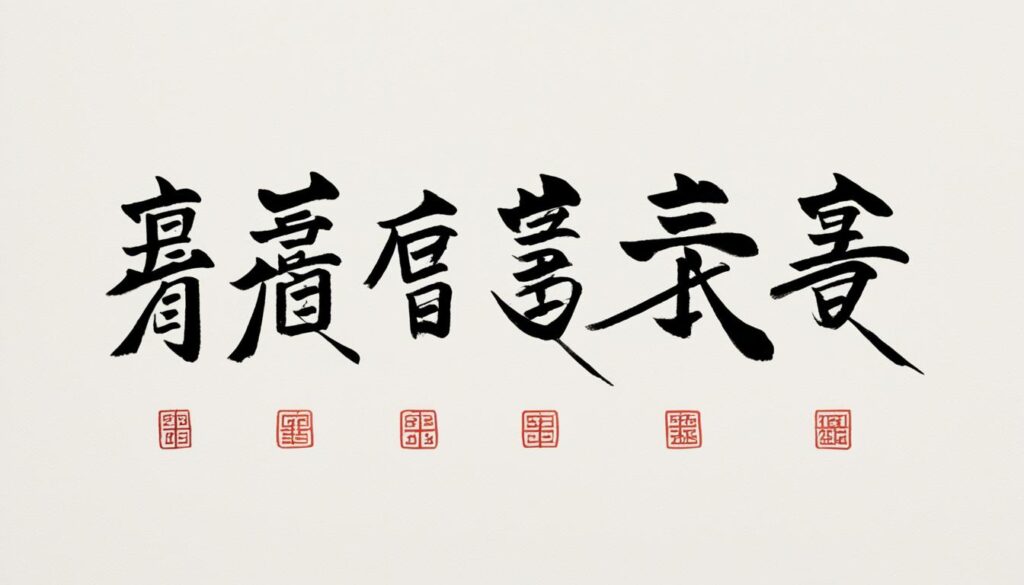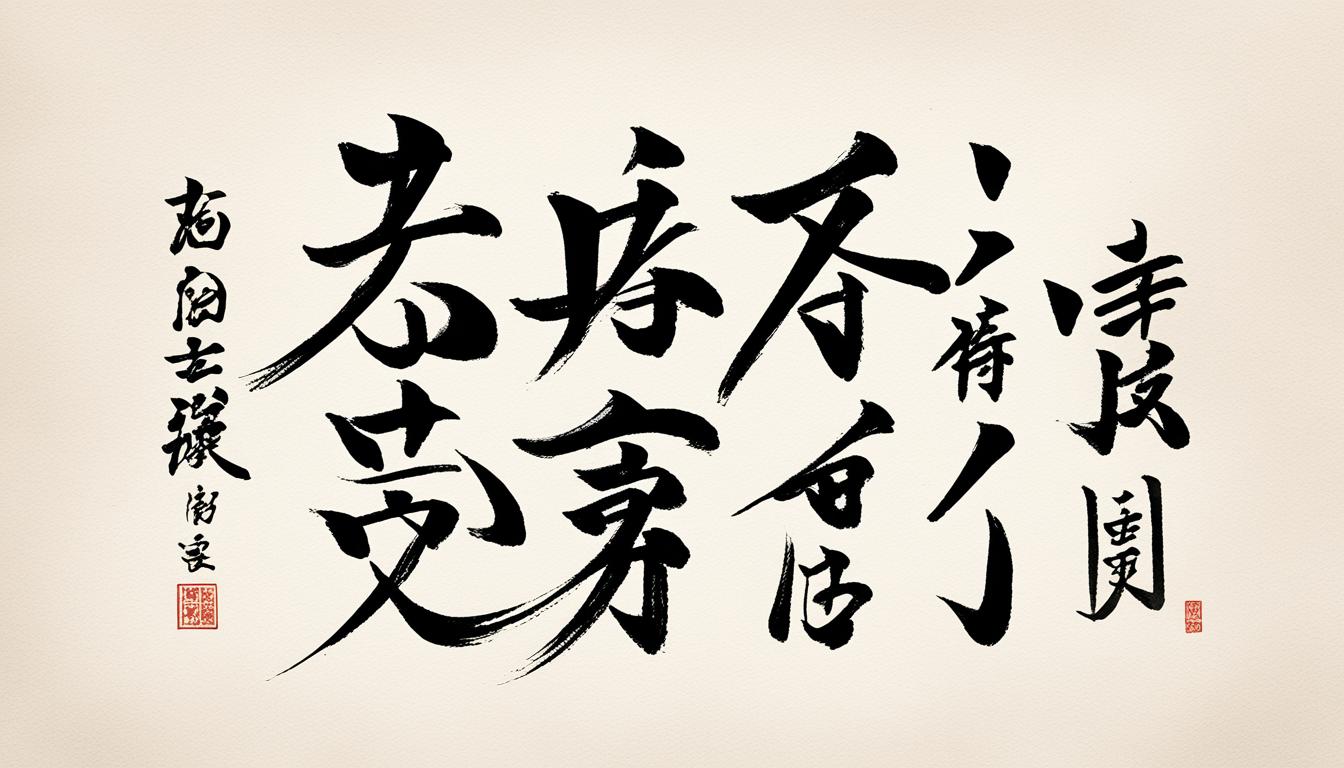Traditional Chinese calligraphy is a captivating art form that has been practiced for centuries in China. It involves the skilled use of a brush and ink to create beautiful and intricate Chinese characters. In this guide, we will explore the tools and techniques used in traditional Chinese calligraphy and provide expert tips to help you master this artistry. Whether you are a beginner or an experienced artist, this article will unlock the secrets to creating your own Chinese ink art.
Key Takeaways:
- Traditional Chinese calligraphy is an ancient art form that uses brushes and ink to create intricate Chinese characters.
- Mastering traditional Chinese calligraphy requires practice, patience, and dedication.
- Essential tools for traditional Chinese calligraphy include rice paper, a calligraphy brush, ink, an ink stone, a paper stop, and a calligraphy mat.
- Properly holding the brush and preparing it with ink are crucial steps in traditional Chinese calligraphy.
- Warm-up exercises and practicing the Eight Principles of Yong are fundamental in learning Chinese calligraphy.
Tools for Traditional Chinese Calligraphy
To practice traditional Chinese calligraphy, you will need several essential tools. These tools include rice paper, a calligraphy brush, ink, an ink stone, a paper stop, and a calligraphy mat.
Rice paper, also known as xuan paper or sumi paper, is the preferred paper for calligraphy practice. It has a smooth texture that allows the brush to glide effortlessly, resulting in beautiful strokes and characters.
The calligraphy brush is a crucial tool in Chinese calligraphy. Traditionally, these brushes are made of weasel or rabbit hair, with a bamboo or wood shaft. The fine bristles of the brush allow for precise control and variation in stroke thickness.
Ink, the heart and soul of calligraphy, brings the characters to life. It is usually produced by grinding ink sticks on an ink stone with water. This traditional method allows the calligrapher to control the concentration and consistency of the ink. However, pre-made bottled inks are also available for convenience.
An ink stone serves as a platform for grinding and containing the ink. It provides a smooth surface for grinding the ink stick and allows the calligrapher to adjust the ink’s concentration and texture according to their preference.
A paper stop is a useful tool that holds down the rice paper while writing, preventing it from sliding or moving. This ensures stability and precision in the brushstrokes.
To protect your work surface and prevent ink from staining, a calligraphy mat is placed under the paper. It provides a cushioned and non-slip surface for comfortable writing.
Here is an overview of the essential tools for traditional Chinese calligraphy:
| Tool | Description |
|---|---|
| Rice paper | A smooth-textured paper for calligraphy practice |
| Calligraphy brush | A brush made of weasel or rabbit hair for precise brushstrokes |
| Ink | An essential material produced by grinding ink sticks on an ink stone |
| Ink stone | A stone used for grinding and containing ink |
| Paper stop | A tool that holds down the paper to prevent movement |
| Calligraphy mat | A protective mat placed under the paper to prevent ink stains |
Holding the Brush and Getting Ready

Properly holding the brush is crucial in traditional Chinese calligraphy. While there are different techniques, it is important to ensure that your index finger and thumb form an oval shape, allowing for maneuverability of the brush. The brush should be held with a relaxed grip, similar to holding a pencil. This grip gives you control and flexibility when creating precise brushstrokes.
Before starting, it’s a good practice to rinse the brush to remove any stiffness and excess water. This step helps to ensure smooth and consistent ink flow. Once the brush is rinsed and prepared, it’s time to prepare the ink.
Brush Preparation:
- Pour ink into an ink stone or container.
- Fully wet the brush with ink by dipping it into the ink.
- Smooth out excess ink on the edge of the ink stone or container.
With the brush fully loaded with ink and excess ink removed, you are now ready to start writing in Chinese calligraphy. The properly prepared brush combined with the correct brush holding technique will allow you to create beautiful and precise strokes.
Now that you have learned how to hold the brush and prepare it, it’s time to move on to warm-up exercises in Chinese calligraphy. These exercises will help improve your brush control and set the foundation for creating stunning Chinese characters.
Warm-up Exercises in Chinese Calligraphy
Before diving into writing Chinese characters, it is important to warm up your hand and familiarize yourself with the basic strokes of Chinese calligraphy. By starting with warm-up exercises, you can enhance your brush control, improve your arm motions, and develop precision in your brushstrokes.
Two popular warm-up exercises in Chinese calligraphy are knitting and ponytail:
- Knitting: This exercise involves drawing swift, clean, thin horizontal and vertical lines to develop control and precision in your brushstrokes. Begin by holding the brush at a 45-degree angle and apply gentle pressure on the paper. Focus on creating smooth and consistent lines, paying attention to the thickness and flow of each stroke. Practice drawing horizontal and vertical lines individually, and then combine them to create squares, rectangles, and other geometric shapes. This exercise helps to warm up your hand and improve your brush control.
- Ponytail: The ponytail exercise focuses on drawing curved lines in various directions, starting from the top and filling in the strokes. Begin by holding the brush at a 45-degree angle and apply gentle pressure on the paper. Start at the top of the stroke and gradually increase the pressure as you move downwards, creating a curved line. Practice drawing curved lines in different directions, gradually increasing the complexity by combining the strokes to form more intricate shapes. This exercise helps to improve your arm motions and brush control.
By incorporating these warm-up exercises into your Chinese calligraphy practice, you can prepare your hand and mind for the intricate strokes required in Chinese characters. Take your time to practice these exercises before starting your writing sessions, as they will help you develop the necessary skills and technique needed for Chinese calligraphy stroke practice.
| Exercise | Description |
|---|---|
| Knitting | Draw thin horizontal and vertical lines to develop control and precision in brushstrokes. |
| Ponytail | Draw curved lines in various directions, starting from the top and filling in the strokes. |
The Eight Principles of Yong – The Fundamentals

The Eight Principles of Yong are a set of basic strokes that form the foundation of traditional Chinese calligraphy. Mastering these fundamental strokes is crucial for creating beautiful and authentic Chinese characters. The Eight Principles of Yong include:
- Horizontal lines
- Vertical lines
- Dot
- Hook
- Left falling
- Right falling
- Rising
- Turning
Each of these strokes has its own unique shape and requires practice to achieve precision and fluidity. By focusing on perfecting each stroke individually, you will develop a better understanding of the structure and aesthetics of Chinese calligraphy.
Here is an example of the Eight Principles of Yong:
| Stroke | Chinese Character | Stroke Example |
|---|---|---|
| Horizontal lines | 一 | |
| Vertical lines | 丨 | |
| Dot | 丶 | https://www.youtube.com/watch?v=qgXTEZ5PqB0 |
| Hook | 亅 | |
| Left falling | 丿 | https://www.youtube.com/watch?v=PN_xfq7HwGE |
| Right falling | 乀 | |
| Rising | ㇏ | https://www.youtube.com/watch?v=NftVxQJ7Bh8 |
| Turning | 乛 |
By practicing these basic strokes, you will gain the necessary skill and confidence to write complete Chinese characters in the future. The Eight Principles of Yong lay the groundwork for mastering the art of Chinese calligraphy.
Conclusion
Traditional Chinese calligraphy is an art form that allows you to delve into the rich cultural heritage of China and express your creativity through the graceful strokes of a brush. As you embark on your journey of mastering traditional Chinese calligraphy, remember that patience and practice are key.
To excel in this artistry, it is essential to invest in high-quality tools that will enhance your experience. The right calligraphy brush, ink, paper, and other materials can make a significant difference in the outcome of your artwork. Ensure that you choose tools that are suited to your style and preferences.
Additionally, pay attention to the proper holding technique for the calligraphy brush and take the time to warm up before each session. These simple practices will help you develop your skills and improve the fluidity of your strokes.
Lastly, focus on mastering the fundamentals of Chinese calligraphy. The Eight Principles of Yong provide a solid foundation for your artwork. By practicing each stroke individually and gradually progressing to complete characters, you will develop a deep understanding of the structure and aesthetics of traditional Chinese calligraphy.
With dedication and perseverance, you can achieve mastery in traditional Chinese calligraphy and unlock the beauty of this ancient artistry. Let the brush guide your creativity, and immerse yourself in the elegance of Chinese ink art. Happy practicing!
FAQ
What is traditional Chinese calligraphy?
What tools do I need for traditional Chinese calligraphy?
How do I hold the brush in traditional Chinese calligraphy?
What are some warm-up exercises in Chinese calligraphy?
What are the Eight Principles of Yong in Chinese calligraphy?
How can I master traditional Chinese calligraphy?
Source Links
- http://afe.easia.columbia.edu/special/china_1000bce_calligraphy.htm
- https://medium.com/@christinakao/special-edition-how-to-get-started-on-chinese-calligraphy-d8cdccbb38c2
- https://asiasociety.org/education/chinese-calligraphy

Average Rating